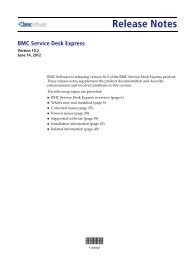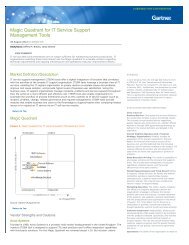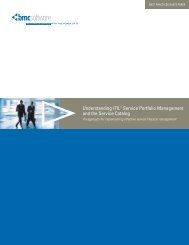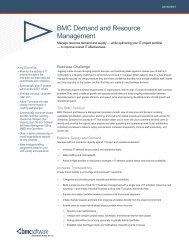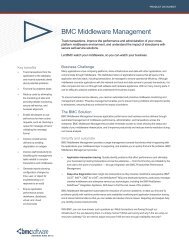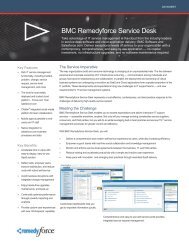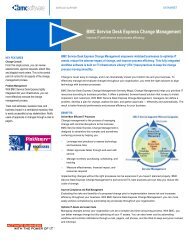Step-by-Step Guide toBuilding a CMDB - RightStar
Step-by-Step Guide toBuilding a CMDB - RightStar
Step-by-Step Guide toBuilding a CMDB - RightStar
You also want an ePaper? Increase the reach of your titles
YUMPU automatically turns print PDFs into web optimized ePapers that Google loves.
Stage 1. Assemble the Project Team and Define the Project<br />
The Importance of the <strong>CMDB</strong> and the Configuration Management Process<br />
Service operation ensures that your customers have access to appropriate IT services that enable the<br />
business. Service operation also ensures consistent functioning of the IT infrastructure upon which the<br />
business depends. With an effective and accurate <strong>CMDB</strong>, you can greatly enhance service operation.<br />
The service desk is a key part of your service operation strategy, because it provides your IT organization’s<br />
face to the customer. Service operation processes help you deliver high-quality service, enabling consistent<br />
availability of the applications that customers want and more immediate response time to failures if they<br />
occur. Without configuration management, these service operation functions cost more and deliver less<br />
value since you must repeat steps to solicit or hunt down component information.<br />
Service operation processes are more effective when they have accurate component-level information. However,<br />
these processes require access to information created in many places and functions within IT. Consolidating<br />
all of this information in a single <strong>CMDB</strong> enables faster resolution of problems, higher success rates for<br />
changes, and fewer unplanned outages. You’ll likely have happier customers, as you’re more likely to<br />
achieve higher service levels, and you’ll also reduce the labor required to continually hunt down componentlevel<br />
information.<br />
Many service operation processes cannot succeed without accurate configuration information. However, this<br />
information is created in a broad range of places and functions within IT. Consolidating all of the information<br />
in a single <strong>CMDB</strong> enables system-level capacity and availability management, continuity and risk planning,<br />
and better overall financial management of IT resources. You also can more effectively utilize scarce IT<br />
resources to improve service levels and service quality. As a result, you can spend less on IT back-office<br />
functions and more on new strategic initiatives to better deliver service.<br />
Asset management. The <strong>CMDB</strong> provides a continually updated relational data repository for<br />
CIs that are considered IT assets. Those responsible for IT asset management can use the <strong>CMDB</strong><br />
to understand the relationship of assets to organizational units, employees, cost centers, solutions<br />
in use, and so forth. This also allows you to understand not only what CIs are considered assets,<br />
but also who is using what assets, where the assets are located, who is paying for the assets,<br />
and what solutions are running on those assets. The <strong>CMDB</strong> enables you to automatically reconcile<br />
and manage data about your deployed assets and their dependencies with business services.<br />
»»<br />
Potential hard benefits: Lower asset TCO and acquisition costs, elimination of unnecessary<br />
duplicate asset purchases, more efficient allocation, more accurate budgeting and planning<br />
»»<br />
Potential soft benefits: More proactive control and greater visibility into your IT assets<br />
throughout their operational lifecycles<br />
Project management. The <strong>CMDB</strong>, along with a change and release management process, provides<br />
the mechanism to identify, plan, track, update, and monitor the projects that create new CIs,<br />
modify CIs, or deploy instances of CIs. Having change and configuration management integrated<br />
into the project management lifecycle is critical to ensuring a smooth project-to-production<br />
transition and accurate CI status.<br />
»»<br />
Potential hard benefits: Improved success rate and reduced costs during projects<br />
»»<br />
Potential soft benefits: Greater staff and customer satisfaction because of smoother<br />
implementation of projects<br />
32



